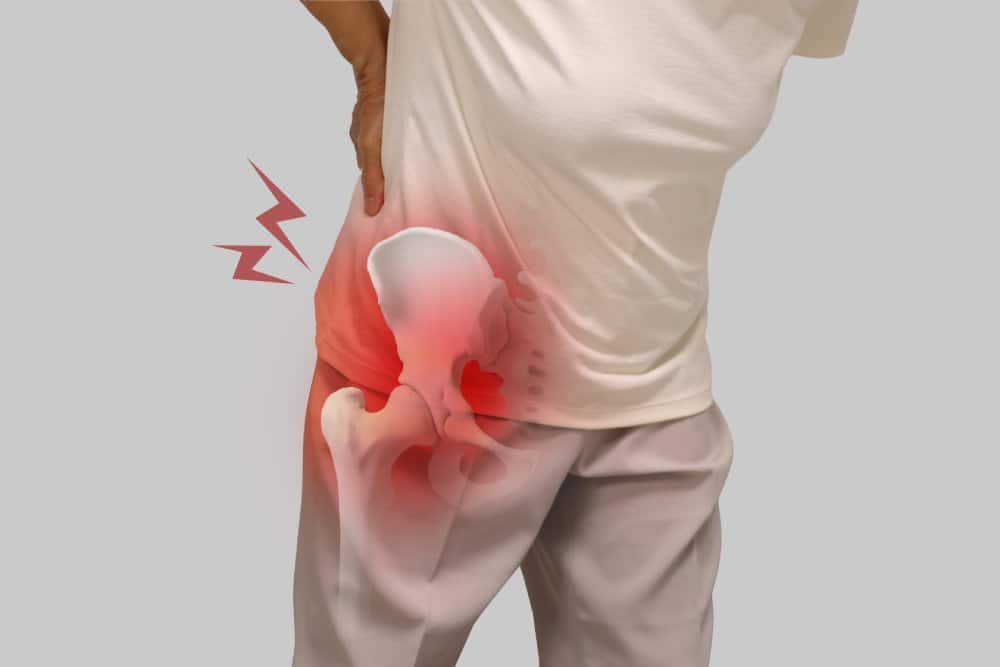Understanding the cause of pain in any major area of the body is important to treating it, and hip pain is no exception. What are some common causes of hip pain, and what might they be suggesting in terms of your treatment and maintenance needs?
At The Orthopaedic Center, we’re proud to offer a wide range of orthopedic services for patients around Tulsa and Jenks, including comprehensive knee and hip services for any need, from simple pain and movement concerns to total knee or hip replacement surgeries. Here are some common causes of hip pain, plus some options available for addressing them.

Hip Bursitis
One of the most common persistent forms of hip pain is caused by bursitis. Bursae are small, fluid-filled sacs that act as cushions between bones and tissues in the joints. When these sacs become inflamed due to overuse or injury, it can result in severe pain and discomfort in the hip area. This condition is known as hip bursitis.
There are several factors that can contribute to the development of hip bursitis, including repetitive motions, poor posture, muscle imbalances, and obesity. It is also common among athletes and individuals who participate in activities that put repeated stress on their hips.
Fortunately, there are various treatment options available for those suffering from hip bursitis. These may include rest, physical therapy, anti-inflammatory medications, and in some cases, cortisone injections. In more severe cases, surgery may be necessary to remove the affected bursa.
Sports Hernia
In other cases, hip pain may actually be caused by a sports hernia, also known as athletic pubalgia. This injury occurs when there is a tear or strain in the muscles and tendons of the lower abdomen. Sports hernias are common among athletes who engage in activities that require sudden changes in direction, such as soccer, hockey, and football.
Symptoms of a sports hernia may include groin pain, especially during physical activity, and abdominal pain when coughing or sneezing. Treatment for this condition typically involves rest, physical therapy to strengthen the affected muscles and tendons, anti-inflammatory medications, and sometimes surgery.
Hip Tendonitis
Especially if you notice most of the pain in the front side of your hip or the groin area, you may be experiencing hip tendonitis. This condition occurs when the tendons in the hip become inflamed or irritated due to overuse or repetitive movements. Runners and athletes who participate in sports that involve a lot of running, jumping, and twisting are at a higher risk for developing hip tendonitis.
Symptoms of hip tendonitis may include pain and stiffness in the front part of the hip, as well as discomfort when walking, climbing stairs, or sitting for long periods of time. Treatment options for this condition may include rest, physical therapy to improve flexibility and strength in the affected area, ice and heat therapy, anti-inflammatory medications, and corticosteroid injections.
Osteoarthritis
Another persistent condition that can affect the hips is osteoarthritis. This occurs when the cartilage in the hip joint wears down over time, causing bones to rub against each other and leading to pain, stiffness, and swelling. Factors such as age, obesity, previous injuries or surgeries, and genetics may increase a person’s risk of developing osteoarthritis.
Treatment for hip osteoarthritis may include weight loss to reduce strain on the joints, low-impact exercises such as swimming or cycling to maintain mobility and strengthen muscles around the hip joint, physical therapy, anti-inflammatory medications, corticosteroid injections, and in severe cases, surgery to replace damaged parts of the joint.
Cartilage Tears
One of the more serious conditions that can affect the hip joint is a cartilage tear. This occurs when the cartilage, which acts as a cushion between bones, becomes damaged or torn due to injury or repetitive stress.
Symptoms of a cartilage tear in the hip may include pain, stiffness, and swelling in the joint, as well as a clicking or catching sensation during movement. Treatment for a cartilage tear may include rest and modifications to activities to allow the tissue to heal, physical therapy exercises to strengthen muscles around the joint, anti-inflammatory medications, and in severe cases, surgery to repair or remove damaged tissue.
Hip Impingement
Another common hip injury is hip impingement, also known as femoroacetabular impingement (FAI). This condition occurs when there is abnormal contact between the ball and socket of the hip joint, causing pain and damage to the surrounding tissues.
There are two types of FAI: cam impingement, which involves a bony overgrowth on the ball of the hip joint, and pincer impingement, which involves an excessive bone growth on the rim of the socket. Both can occur together or independently.
Symptoms of FAI may include pain in the groin or front of the hip during movement, stiffness in the hip joint, and limited range of motion. Treatment for FAI typically involves physical therapy to strengthen the surrounding muscles and improve hip mechanics, but in severe cases, surgery may be necessary.
At The Orthopaedic Center, we’re here to help with any hip injury treatment need around Tulsa or Jenks. Contact us today for help with the common causes of hip pain and how to treat them!